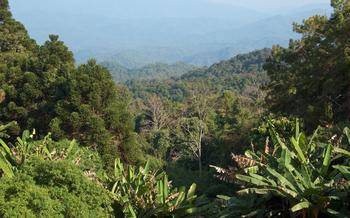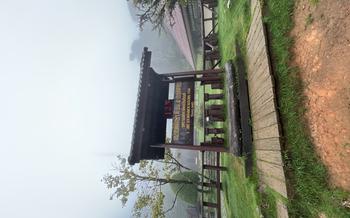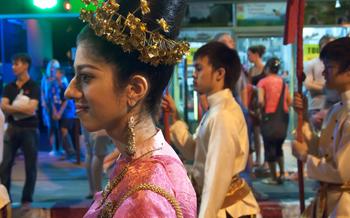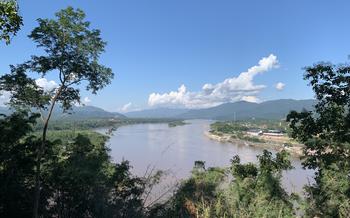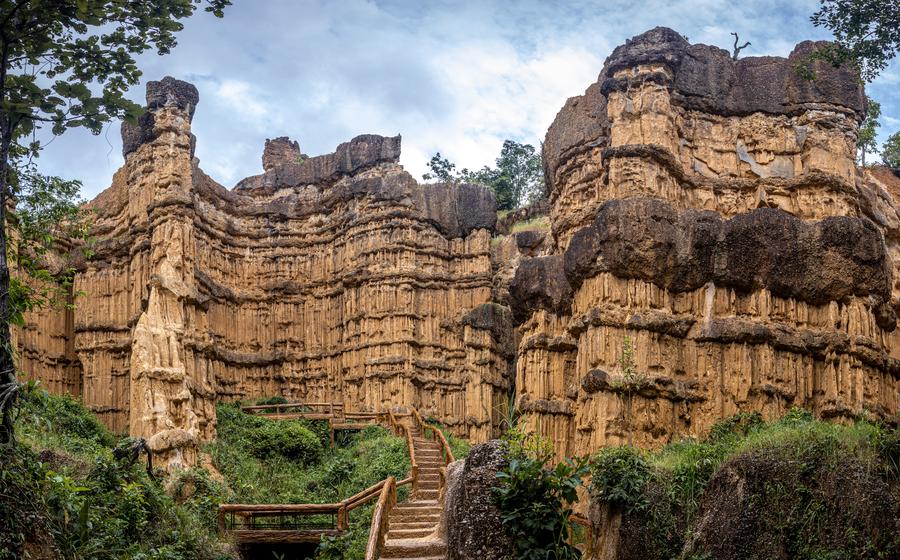
Mae Wang National Park
- Mae Wang National Park: A Haven of Natural Wonders
- Exploring the Lush Jungles
- Conquering Majestic Mountains
- Unveiling Majestic Waterfalls
- Discovering Hidden Caves
- Experiencing Local Hill Tribe Culture
- Camping Under the Stars
- Picnicking in Serene Surroundings
- Mountain Biking Through Rugged Terrain
- Visiting the Royal Agricultural Research Center
- Supporting Local Communities
- Photography Opportunities Galore
- Respecting the Environment
- Planning Your Adventure
- Insider Tip: Hidden Gem
Mae Wang National Park: A Haven of Natural Wonders
Biodiversity Mae Wang National Park is a biodiverse haven, boasting a rich tapestry of flora and fauna. From majestic elephants and agile gibbons to colorful birds and elusive leopards, the park teems with wildlife. The diverse habitats, including lush rainforests, towering mountains, and cascading waterfalls, support a wide range of species, making it a paradise for nature enthusiasts.
Geography Encompassing an area of over 1,000 square kilometers, Mae Wang National Park is situated in the mountainous region of Chiang Mai, Thailand. The park's terrain is characterized by rugged peaks, verdant valleys, and pristine rivers, creating a breathtaking landscape that captivates visitors.
Activities The park offers a plethora of activities for adventure-seekers and nature lovers alike. Explore the intricate network of trekking trails that wind through the jungle, offering encounters with exotic wildlife and breathtaking views. Discover hidden caves adorned with ancient stalactites and stalagmites, providing a glimpse into the park's geological wonders. Embark on challenging hikes to conquer majestic mountains, including Doi Inthanon, the highest peak in Thailand, and be rewarded with panoramic vistas.
Getting There Mae Wang National Park is conveniently accessible from Chiang Mai. Visitors can opt for a scenic bus ride or a comfortable private transfer to reach the park's headquarters. Once there, a network of well-maintained roads and trails allows for easy exploration of the park's diverse attractions.
Exploring the Lush Jungles
Mae Wang National Park is a haven for nature enthusiasts, and its lush jungles offer a multitude of thrilling adventures. Embark on invigorating trekking trails that wind through dense forests, crossing streams and leading to hidden waterfalls. As you navigate the trails, keep your eyes peeled for wildlife encounters, as the park is home to a diverse array of creatures, including gibbons, macaques, and colorful bird species. Birdwatching enthusiasts will be in paradise, with over 300 species recorded within the park's boundaries.
The park's conservation efforts are commendable, and visitors can contribute to these initiatives by adhering to responsible tourism practices. By staying on designated trails, minimizing noise pollution, and avoiding disturbing wildlife, you can help preserve the delicate ecosystem of the park for generations to come.
Conquering Majestic Mountains
Mae Wang National Park is a haven for mountaineering enthusiasts, with Doi Inthanon, Thailand's highest peak, standing tall at 2,565 meters above sea level. Scaling this majestic mountain is a challenging yet rewarding experience, offering stunning panoramic views from its summit. The park also boasts numerous other peaks and ridges, providing trekkers with a range of options to suit their fitness levels and preferences.
The ascent up Doi Inthanon begins at the park headquarters, where trekkers can obtain permits and hire local guides if desired. The trail winds through lush forests, revealing diverse flora and fauna along the way. As the elevation increases, the vegetation changes, showcasing the park's rich biodiversity. Trekkers may encounter colorful birds, playful monkeys, and even elusive bears.
The final stretch to the summit involves a steep climb, but the breathtaking views from the top make it all worthwhile. On a clear day, one can witness a panoramic vista that stretches for miles, encompassing verdant valleys, distant mountain ranges, and even the glimmering waters of the Andaman Sea. The summit is also home to several Buddhist shrines and stupas, adding a spiritual dimension to the experience.
Unveiling Majestic Waterfalls
Mae Wang National Park is a sanctuary for cascading waterfalls that offer a refreshing respite from the tropical heat. The park's most renowned waterfalls are Wachirathan, Siritharn, and Mae Klang, each boasting unique characteristics and captivating beauty.
Wachirathan Waterfall
Wachirathan Waterfall, also known as Mae Wang Waterfall, is the park's most popular waterfall and a must-see for any visitor. The waterfall cascades down three tiers, creating a mesmerizing spectacle of water and mist. Visitors can take a refreshing dip in the plunge pool at the base of the waterfall or simply relax and enjoy the tranquil atmosphere.
Sirithan Waterfall
Sirithan Waterfall is another stunning waterfall located within the park. It features a single, powerful cascade that plunges into a deep pool below. The waterfall is surrounded by lush vegetation, creating a picturesque setting that is perfect for photography and nature appreciation.
Mae Klang Waterfall
Mae Klang Waterfall is a hidden gem located in the remote corner of the park. It is the park's tallest waterfall and offers a challenging but rewarding hike. The trail to the waterfall takes visitors through dense jungle terrain and offers stunning views of the surrounding mountains.
Swimming and Relaxation
All three waterfalls in Mae Wang National Park offer opportunities for swimming and relaxation. Visitors can take a dip in the cool, refreshing water or simply relax on the rocks and enjoy the tranquil atmosphere. The waterfalls are also popular spots for picnics and barbecues.
Discovering Hidden Caves
Mae Wang National Park is home to a network of hidden caves that offer a glimpse into the subterranean wonders of the region. These caves are not only beautiful but also hold significant cultural and historical value.
Tham Lod Cave is one of the most popular caves in the park. It is a large cave with a river running through it. Visitors can explore the cave by boat and see the stunning stalactites and stalagmites that line the walls.
Tham Pha Plong Cave is another popular cave in the park. It is a smaller cave but is known for its impressive rock formations. Visitors can walk through the cave and see the various rock formations, including stalactites, stalagmites, and columns.
Tham Chiang Dao Cave is located near the town of Chiang Dao. It is a large cave with a long history. The cave was once used as a hiding place by the Karen people during the Burmese-Siamese wars. Visitors can explore the cave and see the various chambers and tunnels that make it up.
Experiencing Local Hill Tribe Culture
Mae Wang National Park is home to a diverse array of hill tribe communities, including the Karen, Hmong, and Akha people. These communities have preserved their unique traditions, languages, and way of life, offering visitors a glimpse into the rich cultural heritage of the region.
A visit to a hill tribe village is a must-do experience for anyone interested in cultural immersion. Visitors can interact with local villagers, learn about their customs and beliefs, and witness their traditional way of life. Many villages offer guided tours, allowing visitors to explore their homes, farms, and temples while gaining insights into their daily lives.
One can witness mesmerizing cultural performances, showcasing traditional dances, music, and costumes. These performances offer a vibrant display of hill tribe culture and provide a platform for local artists to share their talents with the world.
For those interested in learning more about hill tribe artistry, there are several handicraft workshops within the park. Visitors can observe skilled artisans creating intricate textiles, bamboo crafts, and silver jewelry, using techniques passed down through generations. These workshops provide a unique opportunity to support local artisans while taking home a piece of hill tribe culture as a souvenir.
Camping Under the Stars
Amidst the tranquil embrace of Mae Wang National Park, camping enthusiasts can indulge in an unforgettable experience beneath a canopy of stars. Designated campsites, nestled amidst the lush wilderness, offer a haven for those seeking a harmonious connection with nature. Tents and camping equipment can be rented on-site, ensuring a hassle-free adventure. As darkness descends, the sky transforms into a celestial tapestry, inviting stargazers to marvel at the shimmering constellations. The serene ambiance of the park provides a sanctuary for introspection and reflection, while the gentle crackling of a campfire lulls campers into a peaceful slumber.
Picnicking in Serene Surroundings
Amidst the natural wonders of Mae Wang National Park, picnicking emerges as a delightful way to savor the tranquility and picturesque landscapes. Designated picnic spots, strategically positioned to offer breathtaking views, invite visitors to unwind and indulge in a culinary feast surrounded by nature's beauty.
Local delicacies and snacks, bursting with authentic flavors, provide the perfect accompaniment to a picnic in the park. From aromatic curries and spicy salads to refreshing fruits and sweet treats, there's a culinary adventure waiting for every palate.
The tranquil atmosphere that permeates the park creates a serene ambiance, conducive to relaxation and rejuvenation. As you spread out your blanket, immerse yourself in the symphony of nature, where the gentle rustling of leaves and the melodious chirping of birds provide a soothing backdrop to your picnic experience.
To ensure the preservation of this pristine environment, responsible waste management is paramount. Dispose of your trash thoughtfully, leaving no trace behind, and contribute to the sustainability of Mae Wang National Park for generations to come.
Mountain Biking Through Rugged Terrain
For adrenaline enthusiasts, Mae Wang National Park offers exhilarating mountain biking trails that traverse through its rugged terrain. These trails cater to riders of all skill levels, from beginners to seasoned experts. Whether you prefer leisurely rides or challenging downhill descents, the park has something for everyone.
Mountain bike rentals are available within the park, along with guided tours for those who prefer to explore with experienced locals. These tours often include visits to hidden trails and scenic viewpoints that are not easily accessible to independent riders.
Before embarking on your mountain biking adventure, ensure you take the necessary safety precautions. Wear protective gear such as a helmet, knee pads, and elbow pads to minimize the risk of injuries in case of a fall. Carry sufficient water and snacks to stay hydrated and energized during your ride.
It is essential to respect park regulations while mountain biking. Stick to designated trails to avoid disturbing wildlife and damaging sensitive ecosystems. Be mindful of other park visitors, especially hikers and wildlife, and yield to them when necessary.
By following these guidelines, you can have an unforgettable mountain biking experience in Mae Wang National Park while respecting the environment and supporting sustainable tourism.
Visiting the Royal Agricultural Research Center
Enrich your visit to Mae Wang National Park with a stop at the Royal Agricultural Research Center, a hub of agricultural innovation and research. Established in 1982, this center plays a crucial role in promoting sustainable agriculture and enhancing the livelihoods of local communities.
Explore the educational exhibits that showcase the latest agricultural techniques and technologies, including sustainable farming practices and crop improvement. Stroll through the botanical gardens, featuring a diverse collection of plants and flowers, and learn about their importance in the local ecosystem.
The center also hosts seasonal festivals that celebrate the local agricultural heritage and showcase the region's rich culinary traditions. These festivals offer a unique opportunity to immerse yourself in the local culture and savor delicious local delicacies.
Supporting Local Communities
Mae Wang National Park offers a unique opportunity to directly support the livelihoods of local communities and contribute to the preservation of their traditional way of life. By engaging in sustainable tourism practices, visitors can have a positive impact on the region's socio-economic development.
Purchasing souvenirs from hill tribe artisans:
- Encourage local craftsmanship and preserve cultural heritage.
- Find unique and authentic souvenirs handmade by skilled artisans.
- Support the economic empowerment of hill tribe communities.
Dining at local restaurants:
- Savor delicious traditional Thai cuisine prepared with fresh local ingredients.
- Support family-run businesses and promote culinary diversity.
- Interact with locals and learn about their culture through food.
Hiring local guides:
- Gain invaluable insights into the park's natural wonders and cultural heritage from experienced local guides.
- Support the livelihoods of individuals who have a deep understanding of the area.
- Contribute to the preservation of traditional knowledge and practices.
Contributing to sustainable tourism:
- Choose tour operators committed to responsible and sustainable practices.
- Respect local customs and traditions to foster mutual understanding.
- Minimize your environmental impact by reducing waste and conserving resources.
- Advocate for the protection and conservation of the park's ecosystems.
By embracing sustainable tourism practices and supporting local communities, visitors to Mae Wang National Park can help ensure that this natural and cultural treasure remains vibrant and sustainable for generations to come.
Photography Opportunities Galore
Mae Wang National Park is a photographer's paradise, offering a kaleidoscope of subjects to capture. From the majestic mountains and cascading waterfalls to the vibrant flora and fauna, there's no shortage of stunning scenes to immortalize. Wildlife enthusiasts can train their lenses on the park's diverse inhabitants, from elusive gibbons to colorful birds. Cultural moments, such as traditional hill tribe ceremonies or bustling local markets, provide a glimpse into the region's rich heritage. And of course, the park's breathtaking landscapes, bathed in golden sunlight or shrouded in mist, make for postcard-perfect shots. Whether you're a seasoned professional or an amateur with a passion for capturing memories, Mae Wang National Park will undoubtedly leave you with a treasure trove of photographs to cherish.
Respecting the Environment
Mae Wang National Park is a treasure trove of natural wonders, and it is essential to treat it with respect. As visitors, we have a responsibility to minimize our impact on the environment and ensure its pristine beauty for generations to come.
-
Avoid Plastic and Littering: Plastic pollution is a significant threat to wildlife and ecosystems. Avoid using single-use plastics and properly dispose of any waste.
-
Stick to Designated Trails: Stay on designated trails to prevent erosion and damage to the delicate flora and fauna.
-
Minimize Noise Pollution: Keep noise levels low to avoid disturbing wildlife and creating a peaceful environment for all visitors.
-
Responsible Wildlife Viewing: Observe wildlife from a distance and avoid disturbing their natural behavior. Refrain from feeding or touching animals.
Planning Your Adventure
Before embarking on your journey to Mae Wang National Park, it's crucial to plan your adventure to ensure a smooth and enjoyable experience. Here are a few essential considerations to keep in mind:
Permits and Fees: To enter the national park, you'll need to obtain a permit from the park headquarters or authorized agents. Fees vary depending on your nationality and the duration of your stay.
Choosing the Right Season: Mae Wang National Park is open year-round, but the best time to visit is during the cool and dry season from November to February. During this time, the weather is ideal for trekking, camping, and wildlife viewing.
Packing Essentials: Pack comfortable clothing suitable for outdoor activities, sturdy hiking shoes, rain gear, a hat, sunscreen, insect repellent, and a first-aid kit. Bring a camera to capture the stunning scenery and wildlife encounters.
Safety Considerations: Although Mae Wang National Park is generally safe, it's essential to prioritize safety. Inform park rangers about your itinerary, stay on designated trails, and be aware of potential hazards like slippery rocks, steep cliffs, and wildlife.
Insider Tip: Hidden Gem
Beyond the well-trodden paths of Mae Wang National Park lies a hidden gem that beckons adventurers seeking tranquility and unique experiences. Mae Wang Reservoir, located in the heart of the park, offers a serene escape from the usual tourist trails. Kayak or boat across the calm waters, surrounded by lush greenery and towering mountains. Discover secluded beaches where you can bask in the sun, swim in the crystal-clear water, or simply relax and soak in the tranquility. This hidden gem is a testament to the diverse beauty of Mae Wang National Park, offering a peaceful retreat for those who seek a more secluded and intimate connection with nature.
